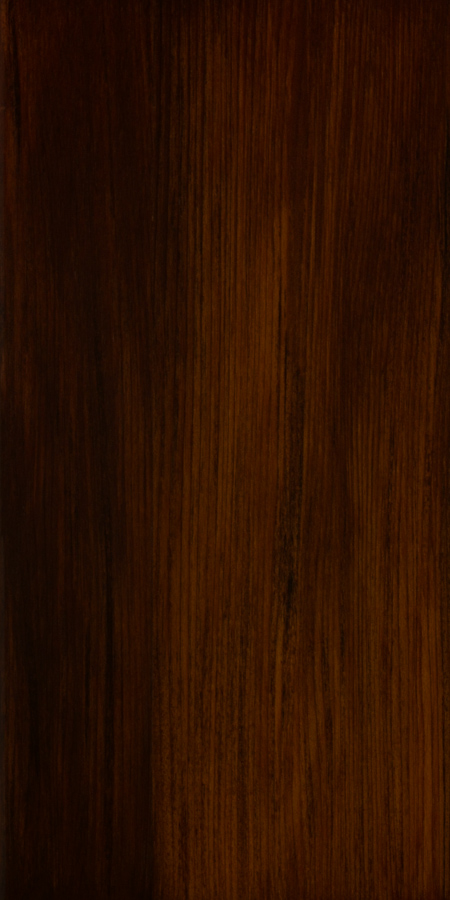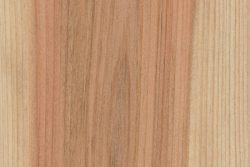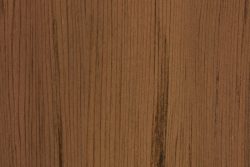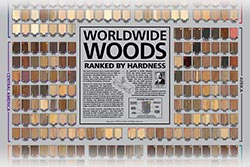Common Name(s): Giant sequoia, giant redwood, sierra redwood, wellingtonia
Scientific Name: Sequoiadendron giganteum
Distribution: California (Sierra Nevada mountain range);
Tree Size: 165-260 ft (50-80 m) tall,
10-20 ft (3-6 m) trunk diameter
Average Dried Weight: 23.3 lbs/ft3 (375 kg/m3)
Specific Gravity (Basic, 12% MC): .33, .37
Janka Hardness: 420 lbf (1,850 N)
Modulus of Rupture: 7,610 lbf/in2 (52.4 MPa)
Elastic Modulus: 985,000 lbf/in2 (6.79 GPa)
Crushing Strength: 4,910 lbf/in2 (33.9 MPa)
Shrinkage: Radial: 1.8%, Tangential: 4.0%,
Volumetric: 6.3%, T/R Ratio: 2.3
Color/Appearance: Heartwood color can range from a light pinkish brown to a deep reddish brown. Sapwood is a pale white/yellow. When compared with the more common coast redwood, heartwood color of giant sequoia tends to be slightly darker, sometimes with a purplish cast.
Grain/Texture: Grain is generally straight, though figured pieces may be be wavy or irregular. Coarse texture with low natural luster.
Rot Resistance: Rated as moderately durable to very durable regarding decay resistance. Lumber from old-growth trees tends to be more durable than that from younger second-growth trees.
Workability: Typically easy to work with hand tools or machinery, but planer tearout can occur on figured pieces with curly, wavy, or irregular grain. Glues and finishes well.
Odor: Giant sequoia has a distinct odor when being worked, though unlike cedar, this odor subsides after being worked.
Allergies/Toxicity: Although there have been no adverse health effects directly associated with giant sequoia, the closely related coast redwood has been reported as a sensitizer. Usually most common reactions simply include eye, skin, and respiratory irritation, as well as asthma-like symptoms. See the articles Wood Allergies and Toxicity and Wood Dust Safety for more information.
Pricing/Availability: Giant sequoia has generally been completely eclipsed by the closely related coast redwood for most commercial purposes. Any potential uses would come from second-growth or plantation-grown trees, making use of the wood’s decay resistance.
Sustainability: This wood species is not listed in the CITES Appendices, but is on the IUCN Red List. It is listed as endangered due to a limited and declining area of occupancy. Even though nearly all giant sequoia groves occur within protected areas, as mature trees gradually die, they are usually replaced with competing conifers, leading to a gradual decline in the native population.[1]Schmid, R. & Farjon, A. 2013. Sequoiadendron giganteum. The IUCN Red List of Threatened Species 2013: … Continue reading
Common Uses: Fence posts, shingles, and match sticks.
Comments: True to its name, giant sequoia trees can reach very large sizes, among the most massive trees on earth.
Unlike most other conifers, lumber taken from old-growth giant sequoia trees tends to yield lumber that is actually weaker, lighter, and more brittle than second-growth trees. (The mechanical values listed at the top of the page represent the averages between both old-growth lumber and second-growth lumber.)
For clarity, the values of each type of lumber is separated out below.[2]Cockrell, R. A., Knudson, R. M., & Stangenberger, A. G. (1971). Mechanical properties of southern Sierra old-and second-growth Giant Sequoia. Bulletin of the California Agricultural Experiment … Continue reading Note the abnormally low MOR and MOE values for old-growth lumber.
| Old-Growth Lumber | Second-Growth Lumber | |
|---|---|---|
| 19.4 lbs/ft3 (310 kg/m3) | 23.7 lbs/ft3 (380 kg/m3) | |
| Janka Hardness: | 360 lbf (1,600 N) | 470 lbf (2,090 N) |
| Modulus of Rupture: | 5,870 lbf/in2 (40.5 MPa) | 9,340 lbf/in2 (64.4 MPa) |
| Elastic Modulus: | 680,000 lbf/in2 (4.69 GPa) | 1,290,000 lbf/in2 (8.90 GPa) |
| Crushing Strength: | 4,420 lbf/in2 (30.5 MPa) | 5,410 lbf/in2 (37.3 MPa) |
Images: Drag the slider up/down to toggle between raw and finished wood.
Identification: See the article on Softwood Anatomy for definitions of endgrain features.
Resin canals : absent
Tracheid diameter : large to very large
Earlywood to latewood transition : moderately abrupt
Grain contrast : medium
Parenchyma : diffuse
Lookalikes/Substitutes: With its very lightweight yet dark reddish brown heartwood (especially after a finish has been applied), there aren’t very many woods that can be confused with coast redwood. The most likely candidate for confusion is western red cedar (Thuja plicata). Generally, cedar is lighter in color than redwood, and has a distinct lingering scent.
Notes: None.
The Sequoiadendron genus contains one other species, S. chaneyi, an extinct prehistoric species, making S. giganteum the sole surviving species today. However, the Cupressaceae family contains a subfamily, Sequoioideae, which contains a total of three extant species—each from three different genera.
Related Content:
References[+]
| ↑1 | Schmid, R. & Farjon, A. 2013. Sequoiadendron giganteum. The IUCN Red List of Threatened Species 2013: e.T34023A2840676. https://dx.doi.org/10.2305/IUCN.UK.2013-1.RLTS.T34023A2840676.en. Accessed on 31 May 2024. |
|---|---|
| ↑2 | Cockrell, R. A., Knudson, R. M., & Stangenberger, A. G. (1971). Mechanical properties of southern Sierra old-and second-growth Giant Sequoia. Bulletin of the California Agricultural Experiment Station, (854). |















